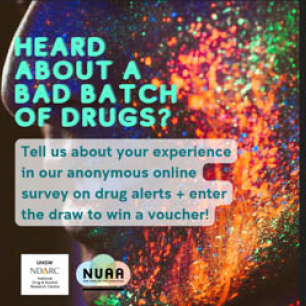This study seeks to understand the awareness, preferences and responses to communication of drug alerts of people who use illicit drugs. We plan to use the study findings to develop practical guidance for stakeholders communicating drug alerts to people who use illicit drugs in Australia.
A/Prof Raimondo Bruno
Dr Monica Barratt
Dr Mary Ellen Harrod
Prof Harry Sumnall
Dr Robert Page
Mr Jared Brown
Ms Alice Pierce
National Centre for Clinical Research on Emerging Drugs
The illicit drug market is unregulated, and the type and quality of substances available can vary widely, with differing risk of harm. People who use drugs often enact harm reduction strategies based on their knowledge of likely substance contents. However, people who use drugs are often unaware of substance contents in terms of the dose and presence of adulterants. This issue has been exacerbated with the emergence of new psychoactive substances (>900 identified) and other significant changes in the drug market (e.g., higher MDMA content of ecstasy tablets/capsules).
Public health agencies and other organisations (e.g., drug checking services) have attempted to make people who use drugs aware of risk of harm from specific substances through ‘drug alerts’, which are defined as communication targeted at consumers about, for example:
- New unknown/high potency substances;
- Substances with severe toxicity profiles;
- High strength/dose substances; and
- Mislabelling/substitution/adulteration of substances.
These alerts are intended to increase awareness of risk of harm and to influence substance-related behaviours to reduce risk of harm (e.g., avoiding or reducing use, use of other harm reduction strategies, engagement with harm reduction/medical services). However, there is a distinct lack of research which assesses communication preferences and evaluates responses to alerts among people who use drugs. It is critical that communication approaches to drug alerts are evidence-based, theory-driven, informed by people who use drugs, and considerate of the potential impacts of such communication.
The findings of this study will allow us to develop guidance that will meet the needs of people who use drugs and are likely to achieve outcomes intended by health agencies and other stakeholders in communicating these alerts – namely increasing awareness of risk of harms and reducing drug-related harms.
This research project aims to recruit an online sample of people who use illicit drugs (at least in the past year, excluding cannabis only users), to examine:
- Preferences for communication of drug alerts,
- Anticipated responses to drug alerts, and
- Consumer awareness of and responses to existing alerts.
This project comprises an online survey of people who use illicit drugs in Australia.
Recruitment for this survey has now closed (September 2023). Results will be made available in the coming months.
The findings from this research project will allow us to develop guidance that will meet the needs of people who use drugs and are likely to achieve outcomes intended by health agencies and other stakeholders in communicating these alerts – namely increasing awareness of risk of harms and reducing drug-related harms.







